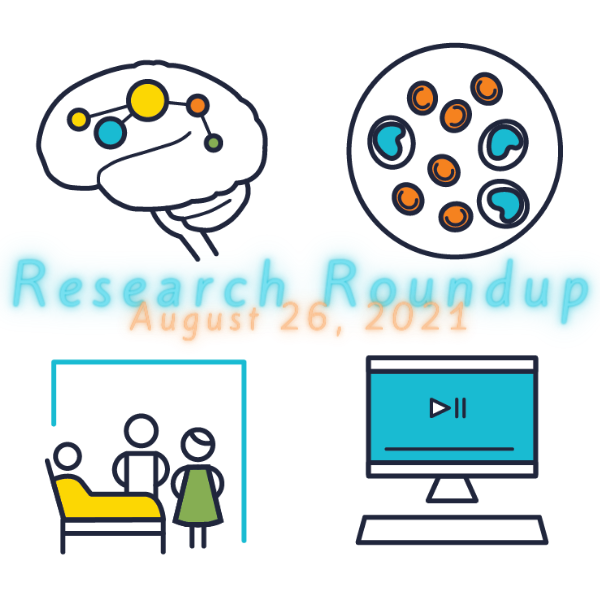Welcome to this month’s Research Roundup, a recurring overview of recent studies published by researchers at BC Children’s Hospital Research Institute (BCCHR) and the University of British Columbia, and their collaborators.

Identifying targets for treating schizophrenia
BCCHR theme: Brain, Behaviour & Development
Schizophrenia is a neurodevelopmental disorder with typical onset between late teens to early 30s. While signs and symptoms vary from person to person, many experience delusions, hallucinations, disorganized thinking and speech, and impaired cognitive function. Individuals with schizophrenia often experience working memory (WM) impairment to such an extent that their day-to-day lives are substantially impacted. While it has long been suspected that WM impairment is caused by dysfunction in the dorsolateral prefrontal cortex in the brain, recent research has indicated that the problem likely originates in networks of brain regions. Dr. Todd Woodward and Nicole Sanford’s multi-experiment approach allowed for a refined evaluation of WM-related networks that are altered in schizophrenia. They discovered that an “energizing” network, engaged during WM encoding, was diminished in schizophrenia patients and activity in this network was correlated with WM performance. Their findings reflect an important step in identifying future targets for schizophrenia treatments that aim to modulate brain networks.
“This research presents a novel approach to functional brain mapping in working memory in schizophrenia, implementing direct comparisons of network engagement across several different forms of cognitive demand,” wrote Dr. Woodward and Nicole Sanford in “Functional Delineation of Prefrontal Networks Underlying Working Memory in Schizophrenia: A Cross-Data-Set Examination.”
Read more in the Journal of Cognitive Neuroscience.
Improving models of childhood acute lymphoblastic leukemia
BCCHR theme: Childhood Diseases
Acute lymphoblastic leukemia (ALL), a type of blood cancer that originates in white blood cells, is the most common cancer in children. While the observed five-year survival for children with ALL aged 14 and under is 94 per cent, the survival rate for those with relapsed ALL is only 30-50 per cent. Patient-specific approaches for disease progression monitoring and treatment development are urgently needed in the case of relapsed ALL. Dr. Gregor Reid, Dr. Nina Rolf, Lorraine Liu, Angela Tsang, Dr. Philipp Lange, Dr. James Lim, Dr. Christopher Maxwell and Dr. Suzanne Vercauteren developed a translational flow cytometry platform to determine the immunophenotypic accuracy of patient-derived xenografts. A patient-derived xenograft (PDX) is a common tool for studying cancer and response to treatment, and involves implanting the tissue or cells from a patient’s tumour into an immunodeficient mouse.
“By incorporating the immunophenotypic complexity of leukemic populations, this novel cross-standardized analytical platform could greatly expand the utility of PDX for investigating ALL progression biology and assessing therapies directed at eliminating relapse-driving leukemic subpopulations,” wrote Dr. Reid and his team in “A Cross-Standardized Flow Cytometry Platform to Assess Phenotypic Stability in Precursor B-Cell Acute Lymphoblastic Leukemia (B-ALL) Xenografts.”
Read more in Cytometry Part A.
Developing concussion education for school professionals
BCCHR theme: Evidence to Innovation
Mild traumatic brain injury — also known as concussion — is common among children and teens, and can interfere with ongoing development. Concussions occur when a blow to the head or body causes the brain to move inside the skull. These sometimes silent injuries (meaning they can occur without visible injury) can lead to several ongoing physical, cognitive, emotional and behavioural symptoms. Unfortunately, there is a lack of knowledge in Canadian schools regarding the signs and symptoms of concussion, along with a lack of formal concussion training for Canadian educators. To address this problem, Dr. Shelina Babul developed the Concussion Awareness Training Tool (CATT), which provides free, evidence-based concussion information delivered in a series of online modules. CATT covers concussion recognition, diagnosis, treatment and management. The CATT for school professionals toolkit (CATT SP) includes school- and classroom-specific concussion education, such as how to support a student when returning to school after a concussion.
“The evaluation of CATT SP as a resource and knowledge translation tool for schools, expanding from the typical concussion audience of coaches, athletes and healthcare professionals, has demonstrated CATT to be both easily accessible and effective in providing evidence-based concussion education,” wrote Dr. Babul, Karen Sadler and Kate Turcotte in “Collaboration, Training and Resources to Support School Policy Development and Recovery From Concussion.”
Read more in Health Behavior and Policy Review.
Classifying concussions with resting state electroencephalogram (EEG) data
BCCHR theme: Healthy Starts
Children and teens are disproportionately affected by concussions and have a longer recovery time than adults. Those who have suffered from a concussion are more prone to experience additional concussions — each time, increasing the risk of long-term physical and mental health complications. The biggest challenge in concussion management is the lack of objective, brain-based approaches for determining whether a young athlete has had a concussion. Dr. Naznin Virji-Babul, Dr. Karun Thanjavur and their collaborators developed a “deep learning long short-term memory (LSTM)-based” recurrent neural network capable of distinguishing between non-concussed and acute post-concussed adolescent athletes using only 90-second samples of resting state EEG data. Their classifier is able to identify concussions with over 90 per cent accuracy.
“This is the first instance of a high-performing classifier that relies only on easy-to-acquire resting state, raw EEG data. Our concussion classifier represents a promising first step towards the development of an easy-to-use, objective, brain-based, automatic classification of concussion at an individual level,” wrote Dr. Virji-Babul and her team in “Recurrent Neural Network-Based Acute Concussion Classifier Using Raw Resting State EEG Data.”
Read more in Scientific Reports.




